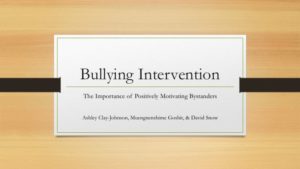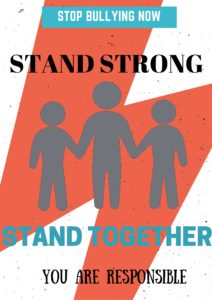Bullying Intervention Group Project Power Point
Intervention Group Project: Bystander Programs
Ashley Clay-Johnson, Muengnenshime Goshit, & David Snow
Bullying intervention strategies can take many forms, from individual-level strategies to school-based strategies, from victim-focused to bully-focused, from punitive to preventative, restorative justice models. While we couldn’t possibly tackle all of the bullying intervention strategies out there, we chose to focus on the impact that bystander programs can have. Our research found that adult intervention is somewhat limited in its effectiveness because bullying often takes place outside of the presence of adults, namely teachers and other school personnel. When victims of bullying were interviewed, many expressed a feeling of being alone, with no one caring about them, and with good reason. Researchers further found that when other students witnessed acts of bullying, in more than eighty percent of observed situations those students cheered on, encouraged and otherwise made comments supporting the bully, not the victim. For purposes of this project, we’ve termed those students as “negative bystanders.” Negative bystanders may feel peer pressure to join in the bullying, may not like the target of the bullying or somehow think that the victim deserves the bullying treatment, may feel less accountable by joining in because it’s become a “group” activity and may see himself or herself as not as culpable as the original bully. By far, the negative bystander behavior is the primary type of behavior that our project and bystander programs generally seek to prevent.
Another type of bystander whose behavior we need to affect is what we call, for purposes of this project, the “indifferent” or “do nothing” bystander. The indifferent bystander purposefully avoids or ignores the bullying, witnesses the bullying but doesn’t take action, or adopts an attitude of “at least it’s not me.” The reasons for a bystander adopting indifferent behavior are varied, but often result from a fear of becoming the next victim, a fear of retribution from the bully, and a belief that it’s “not my problem.” Sometimes, indifferent bystander behavior is simply the result of the student not knowing what to do in the situation. Unfortunately for the indifferent bystander, he or she often still suffers negative consequences, such as guilt and anxiety over the bullying event.
Bystander education is focused around motivating and encouraging the positive involvement of bystanders who witness bullying events. Given that much bullying behavior often goes unreported to teachers and school personnel and that teachers intercede in only 15% to 18% of classroom bullying episodes, equipping other students who may witness bullying to intercede on behalf of the victim is necessary to combat bullying in situations where an adult presence may not occur. Research also shows that when bystanders intervened in the bullying, the same research showed the bullying tended to stop quickly; other research showed that close to 50% of all bullying events stop when a bystander decides to intervene. If we can find an effective way to discourage negative bystander behavior and instead encourage negative and indifferent bystanders to become positive intervenors, bystanders could be powerful agents of stopping bullying of their peers.
The first step to bystander education is developing by group consensus definitions of unacceptable behavior, including bullying and negative bystander behavior. In defining what behavior is “right” and “wrong,” it’s important for teachers to use concepts of social justice and fairness to obtain buy-in from students. The movie “Bully” showed how important it was for groups to acknowledge a problem and try to correct it. When schools in “Bully” failed to acknowledge the bullying that went on among its students, parents and the community turned to town hall meetings to address the problems. Similarly, teachers and administrators who have recognized a bullying issue can and should acknowledge that a problem exists and seek to remedy it through forum-like discussions. When students have participated in developing a code of acceptable behavior, teachers can then hold students accountable for deviations of that behavior. It’s particularly important that negative bystander behavior is identified as unacceptable – if we can’t discourage negative bystander behavior, the bystander program will be ineffective. Creating a culture of accountability is also important to inspire and transform bystanders into positive intervenors – the act of intervention is grounded in a willingness to hold bullies accountable to standards of conduct and enforce concepts of fair play.
As a group, we developed a power point presentation to impress upon teachers/administrators the importance of the bystander role in bullying, to convey the basic tenets of bystander programs to teachers and administrators, and to provide tips regarding what to do when teachers and administrators witness negative bystander behavior or positive intervenors. The research suggests that if we can inspire bystanders to intervene on behalf of a victim, half or more of all bullying events may be quickly stopped. However, we face challenges in truly measuring the successfulness of bystander programs. These programs are meant to address bullying that occurs “under the radar,” the bullying that goes unreported to teachers/administrators, so it’s difficult to obtain objective results demonstrating the effectiveness of such programs.
Current resources and thinking for bystander programs particularly focus on implementation in the school and classroom settings. One tool that is often neglected, and has been with these programs, is the role and support of the parents. We’ve identified teachers/administrators as resources for bullying intervention, but parents can also be powerful resources. We’d advocate that parents be included in the bystander program education, be introduced to the concepts of negative and indifferent bystander behavior, and receive both the standards of conduct and the strategies for intervening on behalf of a bullying victim that we are giving our students. That way, parents can reinforce a consistent message that if a student feels safe, he or she should intervene for a victim and stand up to a bully, and if not, he or she needs to get help from other students or an adult.
Research Sources:
Bully. Dir. Lee Hirsch. Weinstein Company, 2012. Film.
“Bullying: What It Is & What Schools Can Do About It.” InterventionCentral. n.p., n.d. Web. 29 May 2016.
“Bystander.” Eyes on Bullying. Education Development Center, Inc., 2008. Web. 30 May 2016.
“Bystanders’ role in bullying.” ReachOut.com. n.p., n.d. Web. 29 May 2016.
“Bystanders: Turning Onlookers into Bully-Prevention Agents.” InterventionCentral. n.p., n.d. Web. 30 May 2016.
“Expert Opinions—Students Speak About Bullying.” Teaching Tolerance. Southern Poverty Law Center, 2016. Web. 29 May 2016.
Frey, Karin S., et al. “Reducing Playground Bullying and Supporting Beliefs: An Experimental Trial of the Steps to Respect Program.” Developmental Psychology 41.3 (2005): 479-91. Print.
NoBullying.com: The Movement Against Bullying. Web. 29 May 2016.



Recent Comments